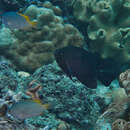en
names in breadcrumbs


Neoglyphidodon crossi is a species of damselfish found in the western and central Pacific. It can grow to a maximum of 10 centimetres (3.9 in) in length.[1] It occasionally makes its way into the aquarium trade.
Neoglyphidodon crossi is found in mostly in the Pacific Ocean. It is found around Indonesia, the Philippines, and Papua New Guinea.[1] They are found at a depth range of 1 to 12 metres (3.3 to 39.4 ft).[1] Usually, they are found in coral reefs.
Adults can grow up to a maximum size of 10 centimetres (3.9 in).[1] They have 13 dorsal spines, 14 to 16 dorsal soft rays, 2 anal spines, and 13 to 14 anal soft rays.[1] Juveniles are orange with a black bottom and a blue line that extends from its snout to its caudal pentacle. Adults are more grayish with less orange spots and their line is less blue.
This fish is omnivorous.
Adults of this species are solitary.[1]
This fish is found in the aquarium trade.
Females lay into the substrate. The males then guard and aerate the eggs until they hatch.[1]
Neoglyphidodon crossi is a species of damselfish found in the western and central Pacific. It can grow to a maximum of 10 centimetres (3.9 in) in length. It occasionally makes its way into the aquarium trade.